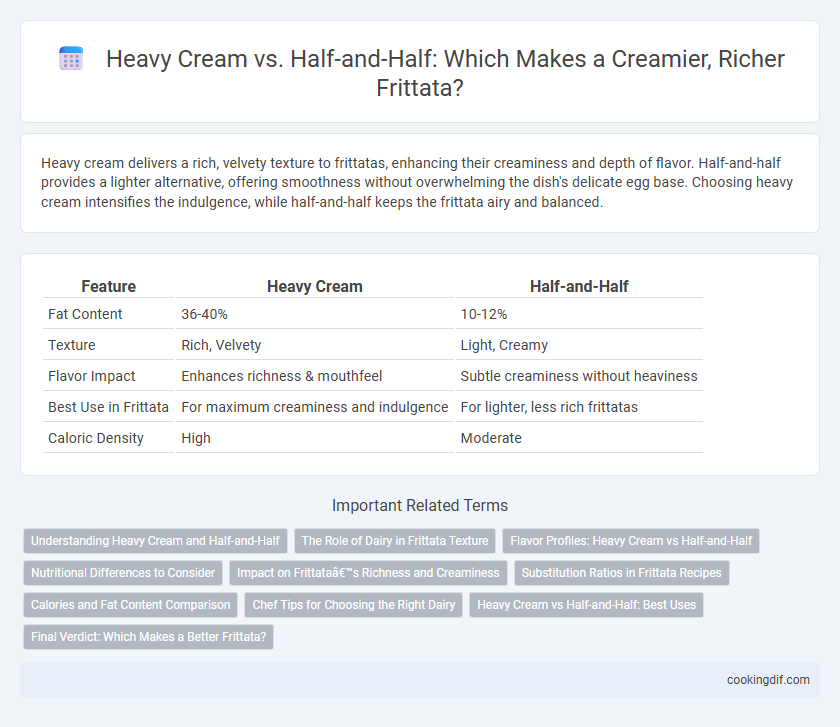Heavy cream delivers a rich, velvety texture to frittatas, enhancing their creaminess and depth of flavor. Half-and-half provides a lighter alternative, offering smoothness without overwhelming the dish's delicate egg base. Choosing heavy cream intensifies the indulgence, while half-and-half keeps the frittata airy and balanced.
Table of Comparison
| Feature | Heavy Cream | Half-and-Half |
|---|---|---|
| Fat Content | 36-40% | 10-12% |
| Texture | Rich, Velvety | Light, Creamy |
| Flavor Impact | Enhances richness & mouthfeel | Subtle creaminess without heaviness |
| Best Use in Frittata | For maximum creaminess and indulgence | For lighter, less rich frittatas |
| Caloric Density | High | Moderate |
Understanding Heavy Cream and Half-and-Half
Heavy cream contains about 36-40% milk fat, providing a rich and velvety texture that enhances the creaminess of a frittata. Half-and-half, with 10-18% milk fat, offers a lighter option that still adds moisture without overwhelming the dish's delicate egg flavors. Choosing heavy cream results in a denser, more indulgent frittata, while half-and-half maintains a balanced, tender consistency ideal for those desiring richness without heaviness.
The Role of Dairy in Frittata Texture
Heavy cream adds a luxurious, velvety texture to frittatas by increasing fat content, resulting in a richer, creamier mouthfeel. Half-and-half offers a lighter alternative, balancing creaminess with a more delicate texture that prevents the frittata from becoming overly dense. The choice between heavy cream and half-and-half directly influences the tenderness, moisture retention, and overall fluffiness of the frittata, making dairy selection crucial for achieving the desired culinary outcome.
Flavor Profiles: Heavy Cream vs Half-and-Half
Heavy cream delivers a richer, more luxurious texture and a fuller mouthfeel to frittatas due to its higher fat content, enhancing the overall flavor depth with a creamy, indulgent profile. Half-and-half, with its lighter fat content, produces a more delicate, subtle creaminess that allows other ingredients like herbs and cheeses to shine without overpowering the dish. Choosing heavy cream intensifies the savory richness, whereas half-and-half maintains a balanced, lighter flavor ideal for those seeking less heaviness.
Nutritional Differences to Consider
Heavy cream contains about 36-40% milk fat, offering a richer, creamier texture and higher calorie content for frittatas, while half-and-half has around 10-18% milk fat, resulting in a lighter dish with fewer calories. Nutritionally, heavy cream provides more fat and saturated fat per serving, which can enhance mouthfeel but may increase cholesterol intake, whereas half-and-half offers a moderate fat content suitable for those seeking a balance between creaminess and lower calorie consumption. Choosing between them depends on dietary goals, where heavy cream suits indulgent recipes and half-and-half supports a lighter, healthier frittata option.
Impact on Frittata’s Richness and Creaminess
Heavy cream significantly enhances a frittata's richness and creaminess due to its higher fat content, creating a velvety texture and luxurious mouthfeel. Half-and-half offers a lighter alternative, providing moderate creaminess without overpowering the eggs, resulting in a more delicate, fluffy frittata. Choosing heavy cream intensifies flavor and indulgence, while half-and-half balances richness with a less dense, tender bite.
Substitution Ratios in Frittata Recipes
Heavy cream enhances frittata richness with a higher fat content, typically using a 1:1 substitution ratio when replacing half-and-half for a creamier texture. Half-and-half, containing less fat, can be increased by 25% in volume to approximate heavy cream's effect without overpowering the dish. Adjusting the liquid ratio ensures the frittata maintains optimal moisture and fluffiness while balancing richness.
Calories and Fat Content Comparison
Heavy cream contains about 52 calories and 5.5 grams of fat per tablespoon, offering richer texture and higher fat content ideal for creamy frittatas. Half-and-half provides approximately 20 calories and 1.7 grams of fat per tablespoon, resulting in a lighter but less rich dish. Choosing heavy cream increases calorie and fat intake significantly, enhancing frittata richness, while half-and-half serves as a healthier alternative with reduced calories and fat.
Chef Tips for Choosing the Right Dairy
Heavy cream adds a luxurious, velvety texture and richer flavor to frittatas, enhancing their overall creaminess and body. Half-and-half offers a lighter alternative, producing a tender but less dense dish while reducing fat content for a healthier option. Chefs recommend heavy cream for a decadent breakfast or brunch, while half-and-half suits those seeking a balance between richness and lightness.
Heavy Cream vs Half-and-Half: Best Uses
Heavy cream enhances frittata richness by providing a velvety texture and intense creaminess, ideal for recipes requiring a luxurious mouthfeel and a more custard-like consistency. Half-and-half offers a lighter alternative, balancing creaminess and lower fat content, making it suitable for healthier frittatas without sacrificing moisture. Choosing between heavy cream and half-and-half depends on the desired richness and calorie level, with heavy cream preferred for indulgence and half-and-half for a lighter, yet still creamy, result.
Final Verdict: Which Makes a Better Frittata?
Heavy cream adds a luxurious, velvety texture to a frittata, enhancing its richness and creating a custard-like interior. Half-and-half offers a lighter option, providing creaminess without overwhelming the egg's flavor or adding excessive calories. For a perfectly balanced frittata that is rich yet not too dense, heavy cream is the superior choice, delivering a creamy mouthfeel and enhanced depth of taste.
Heavy cream vs half-and-half for frittata richness Infographic

 cookingdif.com
cookingdif.com